
 (732) 246-1377
(732) 246-1377
 (732) 246-1377
(732) 246-1377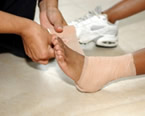 Alec Burks of the Utah Jazz will have to undergo surgery for a broken ankle despite being told no additional surgery would be required. Jazz sources stated, “Alec has chosen to have the surgery because it will potentially allow him to come back at an earlier date.” With Burks away from the Jazz, Coach Quin Snyder will have to decide what is necessary for the team before the All-Star Break.
Alec Burks of the Utah Jazz will have to undergo surgery for a broken ankle despite being told no additional surgery would be required. Jazz sources stated, “Alec has chosen to have the surgery because it will potentially allow him to come back at an earlier date.” With Burks away from the Jazz, Coach Quin Snyder will have to decide what is necessary for the team before the All-Star Break.
Foot surgery is a serious deal and typically done if other treatments do not seem to work. If you have any concerns about your feet, contact one of our podiatrists of Livingston Footcare. Our doctors will fulfill your foot and ankle needs.
When Is Surgery Necessary?
Foot and ankle surgery is generally reserved for extreme cases in which less invasive, conservative procedures have failed to help with the problem. Some of the cases in which surgery may be necessary are:
· Removing foot deformities like bone spurs and bunions
· Severe arthritis that has caused bone issues
· Cosmetic reconstruction
What Types of Surgery Are There?
The type of surgery you receive will depend on the nature of the problem you have. Some of the possible surgeries include:
· Bunionectomy for painful bunion growth
· Surgical fusion for realignment of bones
· Neuropathy decompression surgery to treat nerve damage
Benefits of Surgery
Although surgery is usually a last resort, it can provide more complete pain relief compared to non-surgical methods and may allow you to finally resume full activity.
Surgical techniques have also become increasingly sophisticated with technological advancement. Techniques like endoscopic surgery allow for smaller incisions and faster recovery times.
If you have any questions feel free to contact our office located in North Brunswick, NJ. We offer the newest diagnostic tools and technologies to fit your foot and ankle needs.
Read more about When is Foot Surgery Necessary Keeping your shoes clean is one important factor in ensuring your feet stay clean too. Make sure to always wear socks to prevent moisture from accumulating in your shoes or on your feet. Wash your feet often to repel foot odor and odor-causing bacteria. Antiperspirant sprays are also great for killing bacteria and getting rid of foot odor. Other less common solutions include using insoles that have activated charcoal, or carbon. Activated charcoal insoles are absorbent and can be adjusted to fit the size of your shoe. Use moisture-absorbing material like cedar shoe trees or newspaper to put in your shoes after wearing them. Don’t forget to also swap often between different pairs of shoes.
Keeping your shoes clean is one important factor in ensuring your feet stay clean too. Make sure to always wear socks to prevent moisture from accumulating in your shoes or on your feet. Wash your feet often to repel foot odor and odor-causing bacteria. Antiperspirant sprays are also great for killing bacteria and getting rid of foot odor. Other less common solutions include using insoles that have activated charcoal, or carbon. Activated charcoal insoles are absorbent and can be adjusted to fit the size of your shoe. Use moisture-absorbing material like cedar shoe trees or newspaper to put in your shoes after wearing them. Don’t forget to also swap often between different pairs of shoes.
Every day foot care is very important to prevent infection and other foot ailments. If you need your feet checked, see Dr. Dave Poonai of Livingston Footcare. Our doctor will treat your feet in addition to other podiatric-related needs.
Every Day Foot Care
Often, people take care of their bodies, face and hair more so than they do for their feet. But the feet are a very important aspect of our bodies, and one that we should pay more attention to. After all, without our feet, we would not be able to perform most daily tasks. It is best to check your feet regularly to make sure there are no new bruises or cuts that you may not have noticed before, for example.
For dry feet, moisturizer can easily be a remedy and can be applied as often as necessary to the affected areas. Wearing shoes that fit well can also help you maintain good foot health, as well as making it easier to walk and do daily activities without the stress or pain of ill-fitting shoes, high heels, or even flip flops.
Also, wearing clean socks with closed shoes is important to ensure that sweat and bacteria do not accumulate within the shoe. Clean socks help to prevent athlete’s foot, fungi problems, bad odors, and can absorb sweat.
If you have any questions please feel free to contact our office located in North Brunswick, NJ. We offer the newest diagnostic tools and technology to treat your foot and ankle needs.
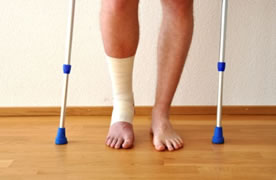 Duke’s senior forward Amile Jefferson will be sidelined for a month following a broken right foot injury after the game against Utah in Madison Square Garden. Jefferson is considered Duke’s “most consistent front court player” in the season and his absence will impact the team. Jefferson averages 11.4 points. Duke won the game against Utah with a score of 9-1, a new record.
Duke’s senior forward Amile Jefferson will be sidelined for a month following a broken right foot injury after the game against Utah in Madison Square Garden. Jefferson is considered Duke’s “most consistent front court player” in the season and his absence will impact the team. Jefferson averages 11.4 points. Duke won the game against Utah with a score of 9-1, a new record.
A broken foot requires immediate medical attention and treatment. If you need your feet checked, see Dr. Dave Poonai of Livingston Footcare. Our doctor will treat your feet in addition to other podiatric-related needs.
Broken Foot Causes, Symptoms, and Treatment
A broken foot is caused by one of the bones in the foot typically breaking when bended, crushed, or stretched beyond its natural capabilities. Usually the location of the fracture indicates how the break occurred, whether it was through an object, fall, or any other type of injury.
Common Symptoms of Broken Feet:
Bruising
Pain
Redness
Swelling
Blue (foot)
Numbness
Cold
Misshapen
Cuts
Deformities
Those that suspect they have a broken foot shoot seek urgent medical attention where a medical professional could diagnose the severity.
Treatment for broken bones varies depending on the cause, severity and location. Some will require the use of splints, casts or crutches while others could even involve surgery to repair the broken bones. Personal care includes the use of ice and keeping the foot stabilized and elevated.
If you have any questions please feel free to contact our office located in North Brunswick, NJ. We offer the newest diagnostic tools and technology to treat your foot and ankle needs.
 Photographer Stacy Kranitz, picked by Time magazine as Photographer of the Year 2015, suffered from plantar warts during the height of her career. Kranitz walked along the streets of California photographing people for a project, searching for young people to connect with. She says that her case of plantar warts “forc[ed] her to work more intimately with people,” as she could not walk very well because of the pain. Kranitz’s project focused on poverty and culture, often engaging closely with her photograph subjects.
Photographer Stacy Kranitz, picked by Time magazine as Photographer of the Year 2015, suffered from plantar warts during the height of her career. Kranitz walked along the streets of California photographing people for a project, searching for young people to connect with. She says that her case of plantar warts “forc[ed] her to work more intimately with people,” as she could not walk very well because of the pain. Kranitz’s project focused on poverty and culture, often engaging closely with her photograph subjects.
Plantar warts can be very uncomfortable. If you need your feet checked, see Dr. Dave Poonai of Livingston Footcare. Our doctor will treat your feet in addition to other podiatric-related needs.
About Plantar Warts
Plantar warts are the result of HPV, or human papillomavirus, getting into open wounds on the feet. They are mostly found on the heels or balls of the feet.
While plantar warts are generally harmless, those experiencing excessive pain or those suffering from diabetes or a compromised immune system require immediate medical care. Plantar warts are easily diagnosed, usually through scraping off a bit of rough skin or by getting a biopsy.
Symptoms
· Legions on the bottom of your feet, usually rough and grainy
· Hard or thick callused spots
· Wart seeds, which are small clotted blood vessels that look like little black spots
· Pain, discomfort, or tenderness of your feet when walking or standing
Treatment
· Freezing
· Electric tool removal
· Laser Treatment
· Topical Creams (prescription only)
· Over-the-counter medications
To help prevent developing plantar warts, avoid walking barefoot over abrasive surfaces that can cause cuts or wounds for HPV to get into. Avoiding direct contact with other warts, as well as not picking or rubbing existing warts, will help prevent the further spread of plantar warts. However, if you think you have developed plantar warts, speak to your podiatrist. He or she can diagnose the warts on your feet and recommend the appropriate treatment options.
If you have any questions please feel free to contact our office located in North Brunswick, NJ. We offer the newest diagnostic tools and technology to treat your foot and ankle needs.
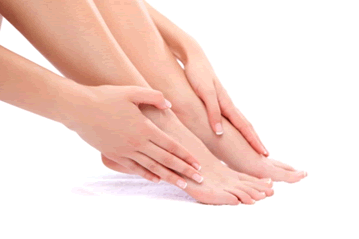 Those with diabetes must manage their feet carefully. Blood sugar levels that aren’t regulated can lead to a loss of feeling in the feet, which can further lead to injuries that may go unnoticed. Injuries that are left untreated can develop into infections, and in very severe cases, may need to be amputated. According to Dr. Rachel Natovich, who presented her research at the American Diabetes Association’s 75th Scientific Sessions along with her colleagues, “a person with diabetes has up to a 25% chance of developing a foot ulcer in their lifetime.” Research also suggested that diabetic patients with foot complications suffered decreased cognitive functioning. Diabetic foot care is important in maintaining a healthy lifestyle and preventing further injury.
Those with diabetes must manage their feet carefully. Blood sugar levels that aren’t regulated can lead to a loss of feeling in the feet, which can further lead to injuries that may go unnoticed. Injuries that are left untreated can develop into infections, and in very severe cases, may need to be amputated. According to Dr. Rachel Natovich, who presented her research at the American Diabetes Association’s 75th Scientific Sessions along with her colleagues, “a person with diabetes has up to a 25% chance of developing a foot ulcer in their lifetime.” Research also suggested that diabetic patients with foot complications suffered decreased cognitive functioning. Diabetic foot care is important in maintaining a healthy lifestyle and preventing further injury.
Diabetic foot care is important in preventing foot ailments such as ulcers. If you need your feet checked, see Dr. Dave Poonai of Livingston Footcare. Our doctor will treat your feet in addition to other podiatric-related needs.
Diabetic Foot Care
Diabetes affects millions of people every year. Diabetes can damage blood vessels in many parts of the body, including the feet. Because of this, taking care of your feet is essential if you have diabetes, and having a podiatrist help monitor your foot health is highly recommended.
The Importance of Caring for Your Feet
· Routinely inspect your feet for bruises or sores.
· Wear socks that fit your feet comfortably.
· Wear comfortable shoes that provide adequate support.
Patients with diabetes should have their doctor monitor their blood levels because blood sugar levels play such a huge role in diabetic care. Monitoring these levels on a regular basis is highly advised.
It is always best to inform your healthcare professional of any concerns you may have regarding your feet, especially for diabetic patients. Early treatment and routine foot examinations are keys to maintaining proper health, especially because severe complications can arise if proper treatment is not applied.
If you have any questions please feel free to contact our office located in North Brunswick, NJ. We offer the newest diagnostic tools and technology to treat your foot and ankle needs.
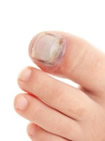 John Lundstram of Oxford United kept on playing despite a broken toe and helped win the game against Cambridge United. Lundstram says, “He was not restricted by the injury,” which occurred, “about five minutes into the second half at Braintree,” when another player stood on his toe. Although there was pain, Lundstram went on to finish the game with his team with a victory.
John Lundstram of Oxford United kept on playing despite a broken toe and helped win the game against Cambridge United. Lundstram says, “He was not restricted by the injury,” which occurred, “about five minutes into the second half at Braintree,” when another player stood on his toe. Although there was pain, Lundstram went on to finish the game with his team with a victory.
A broken toe can be very painful and lead to complications if not properly fixed. If your heel is hurting, see Dr. Dave Poonai of Livingston Footcare. Our doctor will treat your heel pain symptoms in addition to other podiatric-related needs.
What to Know About a Broken Toe
Although most people try to avoid foot trauma such as banging, stubbing, or dropping heavy objects on their feet, the unfortunate fact is that it is a common occurrence. Given the fact that toes are positioned in front of the feet, they typically sustain the brunt of such trauma. When trauma occurs to a toe, the result can be a painful break (fracture).
Symptoms of a Broken Toe
· throbbing pain
· swelling
· bruising on the skin and toenail
· the inability to move the toe
· toe appears crooked or disfigured
· tingling or numbness in the toe
Generally, it is best to stay off of the injured toe with the affected foot elevated.
Severe toe fractures may be treated with a splint, cast, and in some cases, minor surgery. Due to its position and the pressure it endures with daily activity, future complications can occur if the big toe is not properly treated.
If you have any questions please feel free to contact our office located in North Brunswick, NJ. We offer the newest diagnostic tools and technology to treat your foot and ankle needs.
 Baylor freshmen quarterback Jarrett Stidham will be unable to play for the rest of the season due to an ankle injury. Stidham originally began as a starter, where he filled in for Seth Russell, who was also injured. Stidham played a total of 10 games for Baylor for this season, but was hurt during halftime in the game against Oklahoma State. Stidham was replaced by third-stringer Chris Johnson, who helped lead the team to a win.
Baylor freshmen quarterback Jarrett Stidham will be unable to play for the rest of the season due to an ankle injury. Stidham originally began as a starter, where he filled in for Seth Russell, who was also injured. Stidham played a total of 10 games for Baylor for this season, but was hurt during halftime in the game against Oklahoma State. Stidham was replaced by third-stringer Chris Johnson, who helped lead the team to a win.
Barefoot running has its own share of benefits and disadvantages. If you need your feet checked, see Dr. Dave Poonai of Livingston Footcare. Our doctor will treat your growing feet in addition to other podiatric-related needs.
Broken Ankles
A broken ankle is experienced when a person fractures their tibia or fibula in the lower leg and ankle area. Both of these bones are attached at the bottom of the leg and combine to form what we know to be our ankle.
When a physician is referring to a break of the ankle, he or she is usually referring to a break in the area where the tibia and fibula are joined to create our ankle joint. Ankles are more prone to fractures because the ankle is an area that suffers a lot of pressure and stress. There are some obvious signs when a person experiences a fractured ankle, and the following symptoms may be present.
Symptoms of a Fractured Ankle
● Excessive pain when the area is touched or when any pressure is placed on the ankle
● Swelling around the area
● Bruising of the area
● Area appears to be deformed
If you suspect an ankle fracture, it is recommended to seek treatment as soon as possible. The sooner you have your podiatrist diagnose the fracture, the quicker you’ll be on the way towards recovery.
If you have any questions please feel free to contact our office located in North Brunswick, NJ. We offer the newest diagnostic tools and technology to treat your foot and ankle needs.
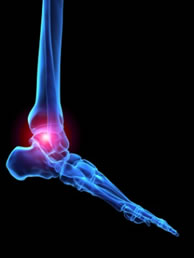 According to a recent global study on Rheumatoid Arthritis (RA), North America has the biggest market for rheumatoid arthritis therapeutics. Europe follows at second. An increasing number of patients with rheumatoid arthritis are emerging in North America, causing a rise in research and development, in awareness among people of the condition, and in improved healthcare in the region. Drugs that treat RA include pain relieving drugs, corticosteroids, disease modifying anti-rheumatic drugs (DMARDs), biologics, and non-biologic drugs.
According to a recent global study on Rheumatoid Arthritis (RA), North America has the biggest market for rheumatoid arthritis therapeutics. Europe follows at second. An increasing number of patients with rheumatoid arthritis are emerging in North America, causing a rise in research and development, in awareness among people of the condition, and in improved healthcare in the region. Drugs that treat RA include pain relieving drugs, corticosteroids, disease modifying anti-rheumatic drugs (DMARDs), biologics, and non-biologic drugs.
Because RA affects more than just your joints, including the joints in your feet and ankles, it is important to seek early diagnosis from your podiatrist if you feel like the pain in your feet might be caused by RA. For more information about Rheumatoid Arthritis and its symptoms, consult with Dr. Dave Poonai of Livingston Footcare. Our doctor will assess your condition and provide you with quality foot and ankle treatment.
What Is Rheumatoid Arthritis?
Rheumatoid Arthritis (RA) is an autoimmune disorder in which the body’s own immune system attacks the membranes surrounding the joints. Inflammation of the lining and eventually the destruction of the joint’s cartilage and bone occur, causing severe pain and immobility.
Rheumatoid Arthritis of the Feet
Although RA usually attacks multiple bones and joints throughout the entire body, almost 90 percent of cases result in pain in the foot or ankle area.
Symptoms
- Swelling & pain in the feet
- Stiffness in the feet
- Pain on the ball or sole of feet
- Joint shift and deformation
Diagnosis
Quick diagnosis of RA in the feet is important so that the podiatrist can treat the area effectively. Your doctor will ask you about your medical history, occupation, and lifestyle to determine the origin of the condition. Rheumatoid Factor tests help to determine if someone is affected by the disease.
If you have any questions please feel free to contact our office located in North Brunswick, NJ. We offer the newest diagnostic tools and technology to treat your foot and ankle needs.
 Samaritan’s Feet, a national faith-based nonprofit that fits children with new shoes at no costs, has donated about 700 shoes to families in Immokalee, Florida. About 36 volunteers helped children clean and fit their feet with new shoes. As kids get older, they quickly outgrow their shoes and periodically need new ones.
Samaritan’s Feet, a national faith-based nonprofit that fits children with new shoes at no costs, has donated about 700 shoes to families in Immokalee, Florida. About 36 volunteers helped children clean and fit their feet with new shoes. As kids get older, they quickly outgrow their shoes and periodically need new ones.
Looking out for potential foot and ankle injuries as well as general health is vital in maintaining proper development in children’s feet. If you need your feet checked, see Dr. Dave Poonai of Livingston Footcare. Our doctor will treat your growing feet in addition to other podiatric-related needs.
Keeping Children's Feet Healthy
Having healthy feet in childhood can help prevent medical problems later in life, namely in the back and legs. As children grow, their feet require different types of care from birth to school-age.
Although babies do not walk yet, it is still very important to take care of their feet.
· Avoid putting tight shoes or socks on his or her feet
· Allow the baby to stretch and kick his or her feet to feel comfortable
As a toddler, kids are now on the move and begin to develop differently. At this age toddlers are getting a feel for walking, so don’t be alarmed if your toddler is unsteady or ‘walks funny’. Be sure the child wears comfortable and protective shoes so that they can grow into their feet properly.
As your child gets older, it is important to teach them how to take care of their feet
Show them proper hygiene to prevent infections such as fungus
Be watchful of any pain or injury
Have all injuries checked by a doctor as soon as possible
Comfortable, protective shoes should always be worn, especially at play
Children of all ages are constantly developing and growing, and as a parent you want to make sure that nothing is hindering their maturation.
If you have any questions please feel free to contact our office located in North Brunswick, NJ. We offer the newest diagnostic tools and technology to treat your foot and ankle needs.
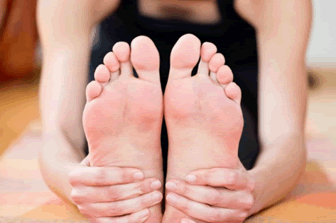 Heel pain can be caused by several different reasons, but one particular condition to look out for is plantar fasciitis. Plantar fasciitis results when the tissue between your heel bone and toes, called the plantar fascia, becomes inflamed. This can be caused by factors such as weight, your age, and the kind of physical activity you do. Women are more prone to plantar fasciitis than men, and it is important that the condition is treated when diagnosed. Some treatment options include physical therapy, exercising programs, deep tissue massage, wearing orthopedics, and surgery.
Heel pain can be caused by several different reasons, but one particular condition to look out for is plantar fasciitis. Plantar fasciitis results when the tissue between your heel bone and toes, called the plantar fascia, becomes inflamed. This can be caused by factors such as weight, your age, and the kind of physical activity you do. Women are more prone to plantar fasciitis than men, and it is important that the condition is treated when diagnosed. Some treatment options include physical therapy, exercising programs, deep tissue massage, wearing orthopedics, and surgery.
Plantar fasciitis can be very painful and inconvenient. If your heel is hurting, see Dr. Dave Poonai of Livingston Footcare. Our doctor will treat your heel pain symptoms in addition to other podiatric-related needs.
What is Plantar Fasciitis?
Plantar fasciitis is the inflammation of the thick band of tissue that runs along the bottom of your foot, known as the plantar fascia, and causes mild to severe heel pain.
What Causes Plantar Fasciitis?
· Excessive running
· Non-supportive shoes
· Overpronation
· Repeated stretching and tearing of the plantar fascia
How Can It Be Treated?
· Conservative measures – anti-inflammatories, ice packs, stretching exercises, physical therapy, orthotic devices
· Shockwave therapy – sound waves are sent to the affected area to facilitate healing and are usually used for chronic cases of plantar fasciitis
· Surgery – usually only used as a last resort when all else fails. The plantar fascia can be surgically detached from the heel
While very treatable, plantar fasciitis is definitely not something that should be ignored. Especially in severe cases, speaking to your doctor right away is highly recommended to avoid complications and severe heel pain. Your podiatrist can work with you to provide the appropriate treatment options tailored to your condition.
If you have any questions please feel free to contact our office located in North Brunswick, NJ. We offer the newest diagnostic tools and technology to treat your foot and ankle needs.
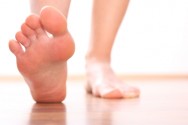 While there can be several different sources behind heel pain, Achilles tendonitis and Achilles bursitis are two types of heel pain that stem from inflammation in the Achilles tendon. Pain in the Achilles tendon typically results from the overuse of the heel. An increase of activity and stress to the heel can lead to tiny tears in the fiber’s tendon, making the tendon unable to repair itself. This is what ultimately leads to pain. Achilles heel pain can be treated with stretches such as the toe stretch, gastrocnemius heel drop, foot and ankle circles, and calf stretches with a towel.
While there can be several different sources behind heel pain, Achilles tendonitis and Achilles bursitis are two types of heel pain that stem from inflammation in the Achilles tendon. Pain in the Achilles tendon typically results from the overuse of the heel. An increase of activity and stress to the heel can lead to tiny tears in the fiber’s tendon, making the tendon unable to repair itself. This is what ultimately leads to pain. Achilles heel pain can be treated with stretches such as the toe stretch, gastrocnemius heel drop, foot and ankle circles, and calf stretches with a towel.
Anyone can wind up suffering from heel pain. If your heel is hurting, see Dr. Dave Poonai of Livingston Footcare. Our doctor will treat your heel pain symptoms in addition to other podiatric-related needs.
Causes of Heel Pain
● Heel pain is often associated with plantar fasciitis. The plantar fascia is a band of tissues that extends along the bottom of the foot. A rip or tear in this ligament can cause inflammation of the tissue.
● Achilles tendonitis is another cause of heel pain. Inflammation of the Achilles tendon will cause pain from fractures and muscle tearing. Lack of flexibility is also another symptom.
● Heel spurs are another cause of pain. When the tissues of the plantar fascia undergo a great deal of stress, it can lead to ligament separation from the heel bone, causing heel spurs.
Why Might Heel Pain Occur?
- Wearing ill-fitting shoes
- Wearing non-supportive shoes
- Weight change
- Excessive running
Treatments
Heel pain should be treated as soon as possible for immediate results. Keeping your feet in a stress free environment will help. If you suffer from Achilles tendonitis or plantar fasciitis, applying ice will reduce the swelling. Stretching before an exercise like running will help the muscles. Using all these tips will help make heel pain a thing of the past.
With the advancements in technology and greater knowledge of how muscles and joints work, physical therapists can turn things around dramatically.
If you have any questions please feel free to contact our office located in North Brunswick, NJ. We offer the newest diagnostic tools and technology to treat your foot and ankle needs.
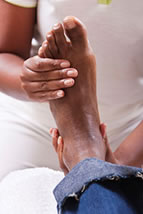 Hammertoe is a common foot condition that can develop over time, often occurring due to the extended wear of high-heeled shoes or shoes that are too small or narrow at the front of the foot. For comfort, the American Academy of Orthopaedic Surgeons recommends that shoes be a half-inch longer than the longest toe. Placing cushioned stick-on pads over hammertoes may help prevent sores, corns, or calluses from forming. Orthotic straps and splints can also help keep a hammertoe in place and help reduce discomfort..
Hammertoe is a common foot condition that can develop over time, often occurring due to the extended wear of high-heeled shoes or shoes that are too small or narrow at the front of the foot. For comfort, the American Academy of Orthopaedic Surgeons recommends that shoes be a half-inch longer than the longest toe. Placing cushioned stick-on pads over hammertoes may help prevent sores, corns, or calluses from forming. Orthotic straps and splints can also help keep a hammertoe in place and help reduce discomfort..  A runner from NY recently wrote in to The Running Doc on Daily News asking why he frequently got ankle sprains. According to The Running Doc, one of the biggest problems when it comes to ankle sprains is knowing your own body and its limits. “The instant you’re hurt ask yourself, ‘Can I keep going?’ If you can still run with the same form and stride, then go ahead. But if you start compensating, or if your biomechanics change even slightly, stop.” He goes on to mention that there is no such thing as a “sprain-prone ankle” which means patients often need to monitor themselves when it comes to their feet in order to more accurately provide a picture of the root causes of your ankle sprains.
A runner from NY recently wrote in to The Running Doc on Daily News asking why he frequently got ankle sprains. According to The Running Doc, one of the biggest problems when it comes to ankle sprains is knowing your own body and its limits. “The instant you’re hurt ask yourself, ‘Can I keep going?’ If you can still run with the same form and stride, then go ahead. But if you start compensating, or if your biomechanics change even slightly, stop.” He goes on to mention that there is no such thing as a “sprain-prone ankle” which means patients often need to monitor themselves when it comes to their feet in order to more accurately provide a picture of the root causes of your ankle sprains.
Ankle sprains are common, but need immediate attention. If you have any concerns about your potential ankle sprain contact Dr. Dave Poonai of Livingston Footcare. Our doctors will treat your foot and ankle needs.
How Does an Ankle Sprain Occur?
Ankle sprains take place when the ligaments in your ankle are torn or stretched beyond their limits. There are multiple ways that the ankle can become injured, including twisting or rolling over onto your ankle, putting undue stress on it, or causing trauma to the ankle itself.
What are the Symptoms?
● Mild to moderate bruising
● Limited mobility
● Swelling
● Discoloration of the skin (depending on severity)
Preventing a Sprain
● Wearing appropriate shoes for the occasion
● Stretching before exercises and sports
● Knowing your limits can aid in prevention
Treatment of a Sprain
Treatment of a sprain depends on the severity. Many times, people are told to rest and remain off their feet completely, while others are given an air cast. If the sprain is very severe, surgery may be required.
If you have suffered an ankle sprain previously, you may want to consider additional support such as a brace and regular exercises to strengthen the ankle.
If you have any questions please feel free to contact our office located in North Brunswick, NJ. We offer the newest diagnostic tools and technology to treat your foot and ankle needs.
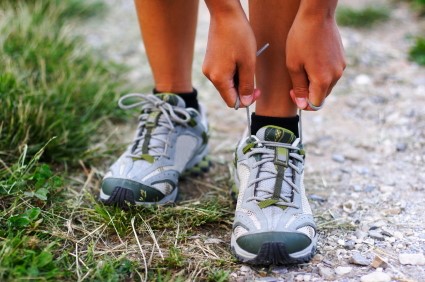 As the summer weather dies down, sandals go back into the closet as we adorn our lower extremities with warmer options such as boots. While getting a fresh pair of boots may be nice, it is important to take the proper measures to avoid blistering on the feet from these new shoes. When first wearing new boots, keep an older pair handy if possible to give your feet a rest from potential friction. Try to break in the new boot by stepping on the heel or walking around with thicker socks on. Investing in blister prevention tools can also result in a pain free boot experience.
As the summer weather dies down, sandals go back into the closet as we adorn our lower extremities with warmer options such as boots. While getting a fresh pair of boots may be nice, it is important to take the proper measures to avoid blistering on the feet from these new shoes. When first wearing new boots, keep an older pair handy if possible to give your feet a rest from potential friction. Try to break in the new boot by stepping on the heel or walking around with thicker socks on. Investing in blister prevention tools can also result in a pain free boot experience.
Blisters are prone to making everyday activities extremely uncomfortable. If you have any concerns with blisters on your feet contact Dr. Dave Poonai of Livingston Foot Care. Our doctors will treat your foot and ankle needs.
Foot Blisters
Foot blisters develop as a result of constantly wearing tight or ill-fitting footwear. This happens due to the constant rubbing from the shoe, which can often lead to pain.
What are Foot Blisters?
A foot blister is a small fluid-filled pocket that forms on the upper-most layer of the skin. Blisters are filled with clear fluid and can lead to blood drainage or pus if the area becomes infected.
How do Blisters Form?
Blisters on the feet are often the result of constant friction of skin and material, usually by shoe rubbing. Walking in sandals, boots, or shoes that don’t fit properly for long periods of time can result in a blister. Having consistent foot moisture and humidity can easily lead to blister formation.
Prevention & Treatment
It is important to properly care for the affected area in order to prevent infection and ease the pain. Do not lance the blister and use a Band-Aid to provide pain relief. Also, be sure to keep your feet dry and wear proper fitting shoes. If you see blood or pus in a blister, seek assistance from a doctor.
If you have any questions please feel free to contact our office located in North Brunswick, NJ. We offer the newest diagnostic tools and technology to treat your foot and ankle needs.